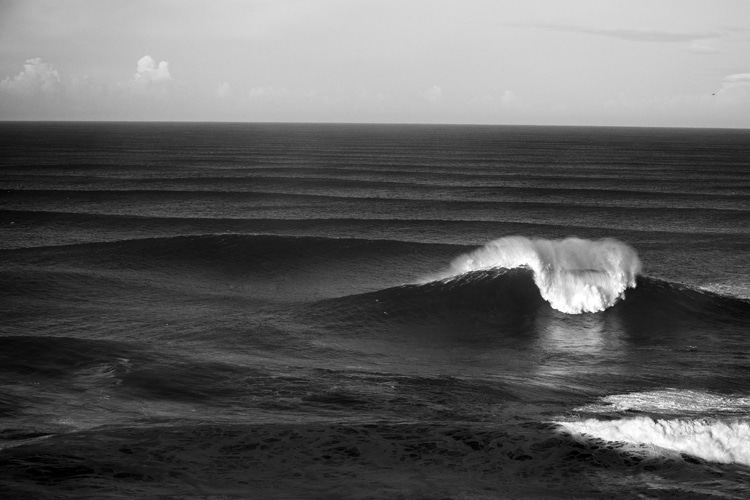There is only one thing that matters at the heart and essence of big wave surfing - to overcome fear and challenge yourself.
In the first two decades of the 21st century, surfing's extreme discipline evolved exponentially across all its variables.
From the athletes' perspective, several layers of highly professional variables were added to the newly created full-time occupation.
Surfers took CPR/AED courses, improved ocean risk management skills, adopted new safety protocols, and embraced static apnea training and high-performance training routines.
They've also learned basic first-aid techniques to address the most common injuries and got in touch with more complex lifesaving methods like joint immobilization, bleeding control, and spinal injury extrication.
After losing a few athletes to the power of Nature, the ever-growing subdiscipline of surfing realized that they needed people who were not riding waves watching for those who were risking their lives in big wave arenas.
Jet ski drivers were replaced by people you could trust, and teams began to form.
Initially, they were not big wave surfers, but as time passed by, it became clear that partners driving and rescuing surfers should also be experienced high surf athletes themselves.
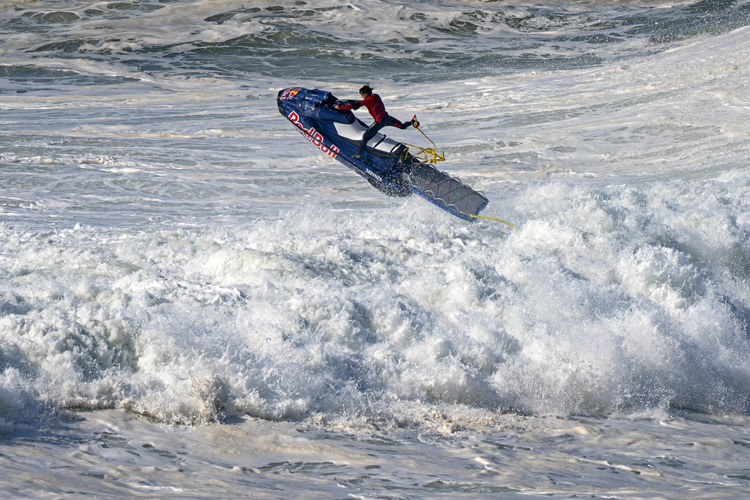
Monetization
Interestingly, the rise of the big wave surfing industry coincides with the rise of the smartphone, the YouTube era, and streaming media.
The creation of digital content became an asset that could be easily monetized and sold through instant wire transfers.
A newspaper or a TV network in Australia can immediately purchase a photo or a 20-second clip featuring a stunt that took place an hour ago.
So, globalization and digital media ended up creating a new multimillion-dollar action sports business, nearly from scratch, in half a decade.
Suddenly, surfers who had a passion for big waves realized they could pursue a career chasing XXL swells and winter storms.
They had all the tools they needed to make it happen - precise surf forecasts, more or less affordable flights, and a growing number of sponsoring opportunities.
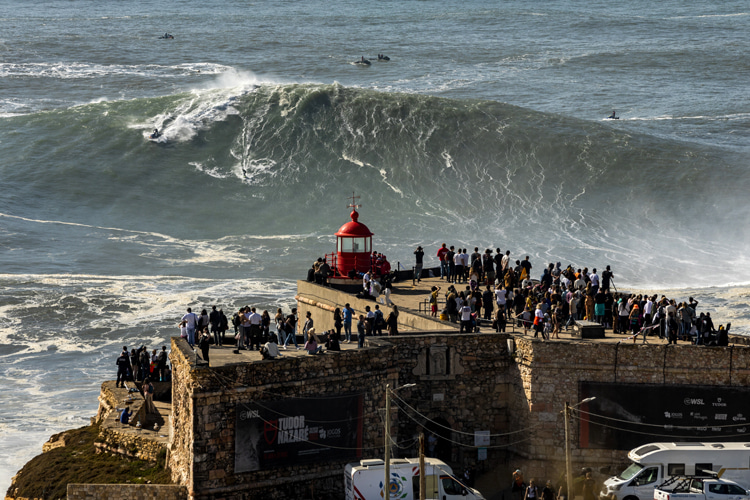
Geoeconomic Lobbies
The event that changed the paradigm was, undoubtedly, Garrett McNamara's 2011 wave ride at Praia do Norte in Nazaré, Portugal.
The Hawaiian had already been surfing the wave for a while, and he became aware of its potential.
Therefore, it was only a matter of waiting for the right moment to change a fishing village's paradigm forever.
A few days after McNamara's spectacular stunt - probably the first big wave to get global media attention - we at SurferToday received an email from someone who was both a journalist and a judge for the Billabong XXL Awards.
SurferToday was one of the first media outlets to break the news when Garrett McNamara rode the famous wave on November 1, 2011.
The journalist/judge wrote SurferToday the following words:
"So, the bottom line reason for the article I'm writing [...] is to essentially question the media's reporting of Garrett McNamara's wave."
"The XXL judging panel is generally recognized - even by the Guinness Book of World Records - as the body that determines whether or not a wave is a world record."
"The vast percentage of 2,500 or so outlets that covered Garrett's Portugal wave - including SurferToday - reported it as a world record."
"Yet this determination was not made by any panel of judges, but rather by the public relations agency covering the Nazaré surf events."
"As such, this whole episode has left many folks I know, including most XXL judges, scratching their heads in a somewhat bemused manner and wondering, 'What just happened here?'"
"Garrett's wave may, in fact, be judged to be a world record, but it also may not. Until that determination is made, the attached photo of Mike Parsons riding a wave in January of 2008, 100 miles out in the middle of the ocean at Cortes Bank, remains - by the reckoning of the XXL judges and Guinness - to be the largest wave ever documented."
"I saw in a later post that you did a 'measurement' of GMAC's wave and asked whether the wave is a record or not, but I didn't see the current record for comparison."
"I seriously mean no disrespect to you or your work, and I'm not questioning Garrett's absolutely massive wave - that will happen when the XXL judges convene. I'm just trying to get a handle on why coverage, in general, wasn't more critical of Garrett's claim."
The journalist wanted to ask SurferToday a few questions:
"So who exactly with Zon Canyon coverage group made the world record determination if not the PR agency?"
"How was it reached, in other words? Was there ever any discussion of using the words' unofficial'?
"The reason I find this so interesting is because, from this example, it seems that any big wave surfer could ride a huge wave and then declare it a world record, and it seems most of the news media would simply go along with that."
"And of course, as you say, everyone wants to hold a world record, but that was why Guinness went to the XXL competition and asked for some sort of official body to determine the waves they publish."
"If the PR agency was doing its job, what was that job exactly? By that, I mean, would it have been better for them to wait until the XXL judging, or was it a smarter move to preemptively declare the wave a record?"
"Again, this is the first time in the fifteen-year history of the XXL competition that a world record has been declared before the judging - so that makes this an interesting event."
SurferToday was open to the journalist's request and answered the questions straight away.
A few months later, when the well-known magazine was published, we realized that our words had been wrongly used to meet the journalist's predetermined ideas on the topic.
But there's more.
He accused SurferToday of "regurgitating the original press release," something which did not happen at all.
The journalist/judge/book author received an email with our complaints but did not reply.
In subsequent years, we gathered the missing pieces of the puzzle and realized that behind big wave surfing's world record wars are huge geoeconomic interests.
If a world record wave goes from Cortes Bank to Jaws, Nazaré to Mullaghmore Head, Teahupoo to Mavericks, or Todos Santos to Pico Alto, there will be books, movies, hotel stays, meals, and indirect tourism activities that will shift from one place to another.
The pressures taking place on the back of a giant wave are immense and, believe it or not, reach the top of the political hierarchy - mayors, prime ministers, and presidents.
And then, inevitably, tension escalates because there's a lot at stake.
Athletes make personal and financial investments to pursue a dream; brands invest millions in sponsoring athletes, and publishers promote both parties and collect a fraction of the revenue; the tourism industry blossoms, and even organizers cash in from municipalities.
It's all interconnected, and, in theory, it's all good. You would say, "It's the economy working."
Until it isn't anymore, especially when one of these multiple sides thinks it's time to earn more money than the others.
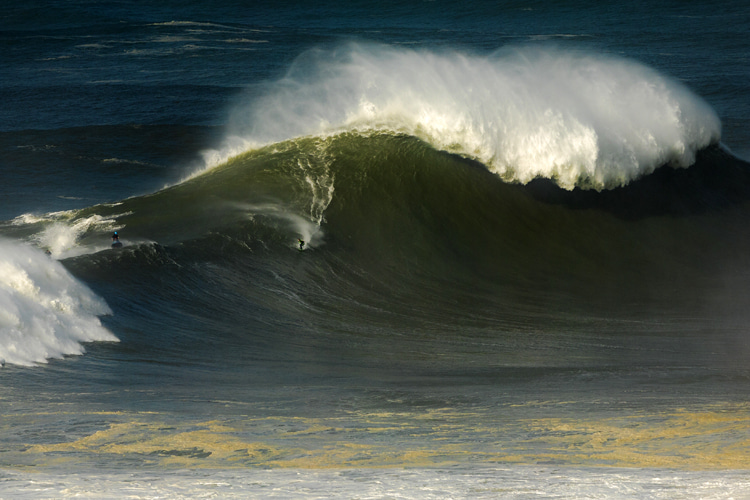
World Record Obsession
As it is today, big wave surfing is mostly focused on setting Guinness World Records.
Why? Because there's not quite a world circuit or a genuinely competitive tour that allows riders to pay their bills and make a living out of risking their lives.
In 2020, an experienced British big wave athlete publicly revealed he was "burnt out from trying to monetize my sport."
The rider in question was fed up with competing at the highest level in a life-threatening discipline that doesn't pay off.
So, for most surfers, it's all about breaking the world record for the biggest wave ever ridden, with all the perks that come with it.
Besides the recognition, there are new sponsorship contracts on the line, sponsorship deal extensions, commercial cameos, ambassador roles, and the good old paycheck.
Unless they are millionaires, nobody is risking their lives just because they love it. If they do, they might be lying to all of us.
The problem with assessing "the biggest wave ever" is that the criteria are not 100 percent objective, scientific, and mathematical.
The professional surfing circuit developed an intelligent yet fallible formula for determining the size of each season's biggest wave rides.
Most big wave surfers work all year - in and out of the water - to be able to find and successfully take off on one of these giant liquid mountains.
However, in surfing, we all know that resources are scarce, and there are no world record-winning waves for each and every athlete.
Poetically, the lineup becomes a gold mine.
Each team does its best to find the ultimate gem during the winter season. And sometimes, a few will do everything needed to get it.
Again, as we've seen before, tension sometimes arises even between surfers and "coworkers," similar to what happens during company hierarchy promotions.
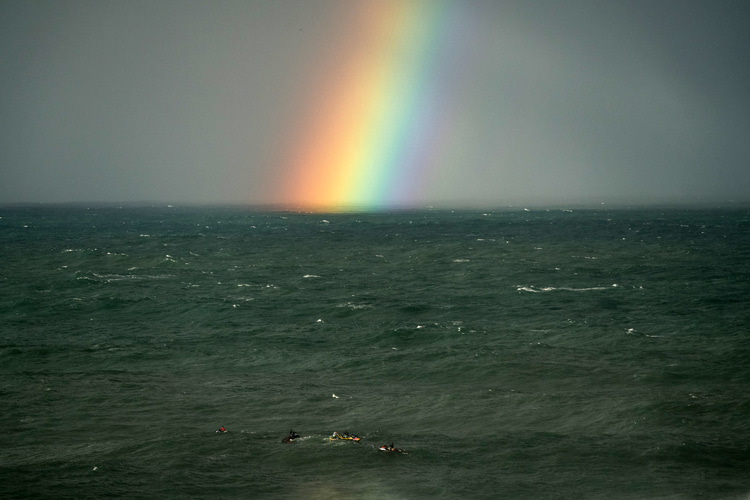
Individualism, Jealousy, and Hypocrisy
Nazaré's Praia do Norte has become the epicenter of big wave surfing.
As a result, the once peaceful fishing village became a lively, go-to destination for the world's finest wave riders.
Many athletes live in Portuguese towns for most of the year.
They believe they should train and get fit in a place that could change their lives forever. And that's generally a good decision.
The problem is there are too many people chasing the same thing.
And suddenly, some of them lose their integrity.
It happened in 2020 with a European surfer who was probably too focused on world records and less on becoming a better person.
His marketing team sent SurferToday footage of him and his partner riding Nazaré waves. The goal was to get him additional promotion on surf media.
The video was edited and published on SurferToday's YouTube channel.
However, a perfectly normal mistake on his side attributed the wrong credits to one of the riders in the video.
The surfer's team rejected our suggestion to cut out the video part with the incorrect credits and asked SurferToday to take the entire video down.
Additionally, and for the first time in over a decade, our website was threatened with a silly lawsuit that would make any judge lose their temper.
With so many relevant things going on in Justice, a surfer was suing a surf media website for publishing a video with a mistake made by his own team.
At the time, we simply shrug our shoulders.
Later, we realized this professional surfer was not only messing with surf media outlets but also with Nazaré locals and surfer colleagues.
Things always happen for a reason.
A few days later, SurferToday received an email from an anonymous individual with some strange revelations.
The email title was "XXL Swell in Nazaré Exposes Strong Undercurrent of Animosity Between Tow Surfing's Biggest Names."
Here's an excerpt:
"As Wednesday drew to a close, the public on the cliff overlooking Praia do Norte saw the remaining tow surfing teams gather in the deep channel abutting the fort of Sao Miguel Arcanjo in apparent celebration of the XXL waves Neptune had sent their way, late in the afternoon."
"But for those who witnessed XX-year-old YYY ZZZ, who is aggressively chasing a Guinness world record at Nazaré, grappling with XX-year-old big wave legend AAA BBB, surrounded by buzzing jet skis, the scene was more reminiscent of Kevin Costner's 1995 flop movie 'Waterworld.'"
"The ensuing altercation involved some of the biggest names in tow surfing, including CCC DDD jumping in the fray to defend his mentor."
"EEE FFF was disgracefully pouring gasoline on the fire, GGG HHH and III JJJ were making honorable but futile attempts at calming things down, and KKK LLL seating things out, looking perplexed by the unlikely turn of events."
"No one knows with certainty what sparked the confrontation."
"But the majority of the professional surfers at Praia do Norte agree that buoyed by the unconditional support of the municipality of Nazaré, the ZZZ/DDD tow surfing duo are seeking to dominate the lineup and displaying increasingly hostile behavior towards other teams, both on and off the water."
"It is a sad day for the sport when big wave surfing's elite end their session brawling rather than celebrating the day's achievements."
The names displayed above were changed to protect everyone involved, and we at SurferToday tried to learn more about the incident.
The anonymous email sender said he was also "happy to identify myself to you, provided that all the background information I share is off the record."
We replied we wouldn't run a story identifying all the involved individuals. And the person in question added the following:
"Last season, I had three separate, ugly episodes with ZZZ, DDD, and their spotter. Until then, I had never been involved in an incident with fellow surfers in Nazaré."
"I understand that competition and aggression go hand in hand."
"But the fact that I am not competing with him - I am one of the very few non-professional surfers at Nazaré and am certainly not in his league - tells me he and his team simply have a huge attitude problem."
"It became clear to me that this attitude problem is becoming an issue for everybody else after personally witnessing his and DDD's disgraceful behavior on the water last Wednesday."
"I appreciate that exposing the dark underbelly of big wave surfing can be detrimental for surfers whose livelihood depends on the sport's clean image."
"But sweeping things under the carpet like the other surfers are doing and projecting a false image of camaraderie will be, in the long run, much more detrimental to the sport and Nazaré."
"I feel strongly that ZZZ's behavior should be exposed so that he starts keeping his ego in check and other teams don't follow in his footsteps."
Final Thoughts
Big wave surfing is not the brotherhood some try to promote.
It's got the same levels of opportunism, camaraderie, greed, trust, rivalry, gratitude, loyalty, sexism, generosity, and segregation you can find in almost any professional activity.
By the way, when was the last time you saw a black surfer taking on a monster wave and getting airplay for their stunt?
Forget the preconceived idea of the surfer as a cool, laid-back, good vibes persona who's in life to spread the Aloha.
That Hollywood cliché might have never existed.
Riding big waves has become an industry that involves not only mainstream and global brands and businesses - including automotive conglomerates, alcohol and energy drinks, and IT conglomerates - but also political and geographical lobbies.
Make no mistake: big wave surfing is a profitable business just like any other. And most importantly, it puts human life at risk.
It's up to each one of us, as stakeholders, to keep it healthy, flourishing, and fair by sticking to values that should never be negotiable.
Words by Luís MP | Founder of SurferToday.com
